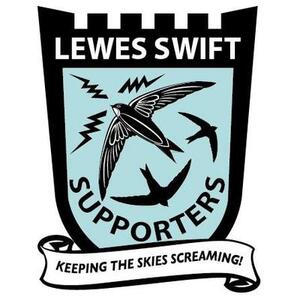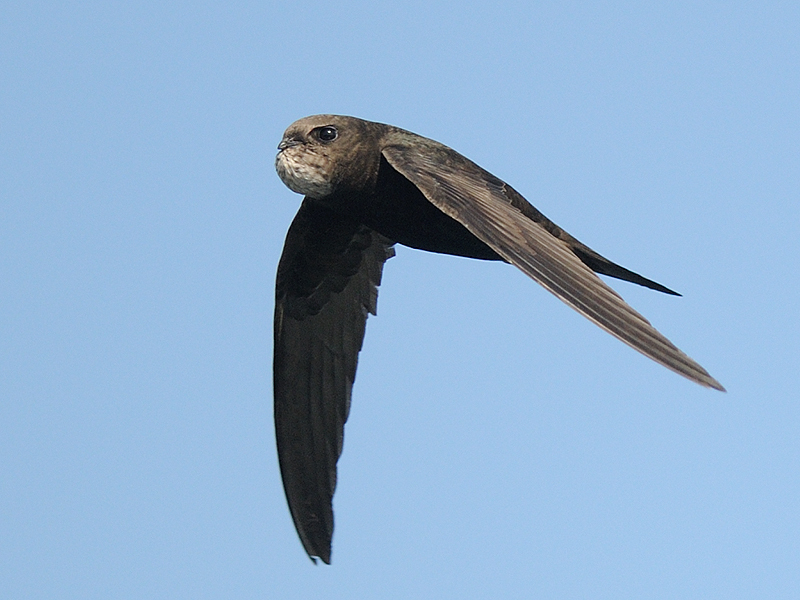Because Swifts spend most of their lives flying through the air they can be difficult to study! There is still a lot that even the Swift experts do not know about them - but what they do know and share is fascinating!
Did you know?
- The habitat of Swifts is in the air! Swifts feed, drink, sleep, and sometimes even mate, on the wing and only land when they are ready to make a nest! In early May you may see them flying as a pair then plummeting together as they mate.
- We usually hear Swifts before we see them. They are famous for their "screaming parties" and are known to respond to calls from other Swifts. Hear the Swift call by visiting this RSPB fact page about Swifts.
- Their wing spans are 30-40 c.m., or 15 -16 inches, and their wings are able to move both forwards and back. Their short take-off, high speed turns and extreme agility have been studied by aerodynamic engineers to inform developments in aeroplane technology!
- Swifts have been recorded as living for as long as 20 years and are extremely faithful to their mates and their nests. Inadequate legal protection for their nests during the months when they are not occupied is a threat to existing colonies.
- Once a fledgling leaves the nest, it will be flying constantly before touching down to breed in its fourth Summer. It is estimated that they fly over 14,000 miles each year! They can fly for up to four days without food or water because their aerodynamic design needs little energy to power their flight.
- Swifts line their nests with any suitable items they can catch as they fly through the air, sticking it together with saliva. Gillian, one of our Supporters who has eight nests at her home, found cobwebs, a small piece of tissue, a fragment of grey and white feather and part of a feather boa amongst the fallen debris from one of her nests. Swift nests should never be removed!
- Swifts eat about 20,000 insects a day. Each ball of food, (bolus), that a parent Swift carries back to the nest for their chicks can contain up to 1,000 insects! They mostly feed on "aerial plankton" such as flying ants, aphids, mosquitoes and spiderlings - but their largest prey is a Hoverfly. They also eat drone Bees which do not have a sting - they can recognise them as drones because they fly at a different altitude and make a different noise.
Swift carrying a bolus of food - by David Moreton, by kind permission of swift-conservation.org
- Swifts have been recorded as flying at a speed of up to 70 m.p.h. and at heights of up to 5,700 metres, (18,700 feet). They have been recorded as flying from Morocco to Cambridge in just two days!
- Although more research into sleeping Swifts is needed, it is widely believed that Swifts can shut off half of their brain so that they can fly and sleep at the same time!
- Swifts are not related to Swallows and Martins - they belong to the same bird family as Hummingbirds, Apodidae.
- Swifts sometimes fly through the rain to have a wash! They can skim low over the surface of water to gather a few drops to drink. This is a very dangerous exercise because if they misjudge and become wet they are likely to go under the water and be caught by a fish.
- Our Swifts winter in Sub-Saharan Africa - the Congo basin, Zimbabwe and Mozambique. Migration flights from tagged birds have been recorded as 12,400 to 17,000 miles - the longest migration for a land bird. They fly to Europe to breed because, compared to the Tropics, we have a longer day length for feeding in Summer. This is essential so that they can catch all the insects that they need to feed their young.
- Most of the Swifts we see in Lewes are Common Swifts. Their scientific name is Apus apus, from the Greek word for "without feet". Because they are flying for much of their lives, in ancient times it was thought that they had no feet! Their feet are further back on their bodies than most birds so they cannot walk easily. They have no "thumb" and all four of their toes point forward so that they can cling to a wall, rock face or a tree trunk and their claws are very sharp. They used to nest in trees, (and still do in Poland, Scotland and Sweden), but largely rely on human habitation for nest sites. For example, under pantiles, in holes in walls, under soffit boards and eaves or in louvred ventilation tiles. This makes them highly vulnerable to renovation and house maintenance!
Thanks to Edward Mayer of Swift Conservation for many of these interesting facts.There is a lot more to find out about Swifts on the Swift Conservation website: swift-conservation.org
Or you might like to read:
- "Swifts in a Tower" by David Lackey
- "Swifts and Swallows" by Mike Unwin, RSPB Spotlight series
- "Vesper Flights" by Helen MacDonald
- "On Crescent Wings" by Jonathan Pomroy, (fantastic paintings!): jonathanpomroy.wordpress.com
- "Swifts and Us" by Sarah Gibson
- "Screamer the Swift" by John Miles and Barry Robson - also available as a video on YouTube
- "One Midsummer's Day - Swifts and the Story of Life on Earth" by Mark Cocker

